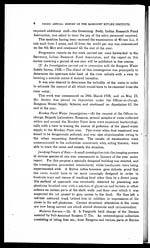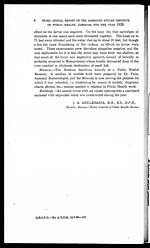Medicine - Institutions > Reports from medical colleges, schools and research institutions > Annual report on the working of the Harcourt Butler Institute of Public Health, Rangoon > Third annual report of the Harcourt Butler Institute of Public Health, Rangoon for the year 1928
(35) Page 5
Download files
Individual page:
Thumbnail gallery: Grid view | List view

OF PUBLIC HEALTH, RANGOON, FOR THE YEAR 1928.
5
was made during the year. These flies were very kindly identified by
Dr. Buxton of the London School of Hygiene and Tropical Medicine,
and specimens required by the British Museum have been presented
thereto.
Publications.—Papers recording the work done on the following
subjects have been submitted for publication in the Indian Journal of
Medical Research and the Indian Medical Gazette:—
(1) A Short Note on the Anopheline Fauna of the Tank West of
the Harcourt Butler Institute of Public Health, Rangoon.
(2) Experiments with Isotex as Larvicide.
(3) Observations on the marking of A. jamesii (Theobald).
(4) Some more variants of A. fuliginosus (Giles) from Burma.
(5) Experiments to note the Larvicidal effects of Sodium Nitrate,
Potassium Nitrate, and Magnesium Sulphate in natural waters.
(6) Results of Experiments with Crude Oil Products of the Burma
Oil Co., Ltd., Rangoon.
(7) A Year's Record of Kata-thermometer readings in Rangoon.
Anti-larval Experiments with Explosives.—Major C. L. Bilderbeck,
I.M.S., investigated the action of explosives on mosquito larvae during
the year.
The water collection considered most suitable for these anti-larval
experiments was a U-shaped tank north of the Harcourt Butler
Institute of Public Health, Rangoon. The length of the tank from end
to end is approximately 150—200 yards,—the breadth varies from 10 to
50 yards and the depth does not exceed 6 feet in its deepest part. The
greater curve of the U had a thick growth of aquatic vegetation, the
edges throughout are overgrown with grass, and under the larger trees
twigs and leaves floated on the water surface.
Previous to the experiments the tank was dragged to save the larger
fish.
Anopheline larvae were collected from other parts and placed at
measured distances from the site at which the explosives were to be
detonated.
In the first experiment a gun cotton primer was submerged to about
a foot below the water's surface and exploded producing only a bubbling
surface bulge as a result. The explosive action did not even injure fish
in the immediate neighbourhood nor anopheline larvae at a distance of
50 feet.
The second experiment with a gun cotton slab placed at a depth of
3 feet below the surface produced a much greater explosion but harmed
neither fish nor larvae; the latter having been placed in the water along
the banks at the same distance as in the first experiment.
The third experiment was undertaken with a one ounce dynamite
cartridge, placed at a depth of 3 feet as in the former experiments, but
although it produced larger ripples and a higher spout of water, the
Set display mode to: Large image | Zoom image | Transcription
Images and transcriptions on this page, including medium image downloads, may be used under the Creative Commons Attribution 4.0 International Licence unless otherwise stated. ![]()
| Permanent URL | https://digital.nls.uk/74950055 |
|---|
| Description | 13 titles. Describes research work and conditions, treatments, vaccine production, medical education, public health and disease outbreaks. Extensive tables show mortality rates and patient admissions. These - some from asylums, jails, dispensaries, civil and police hospitals – will be useful to epidemiologists. |
|---|




